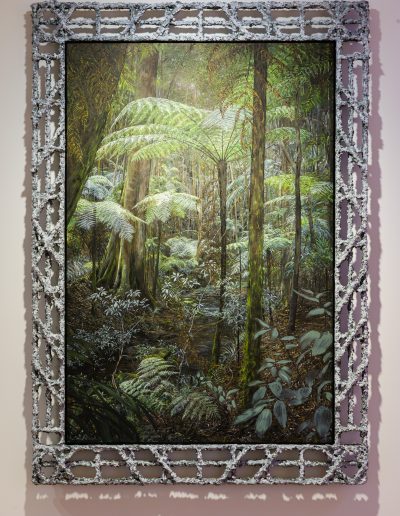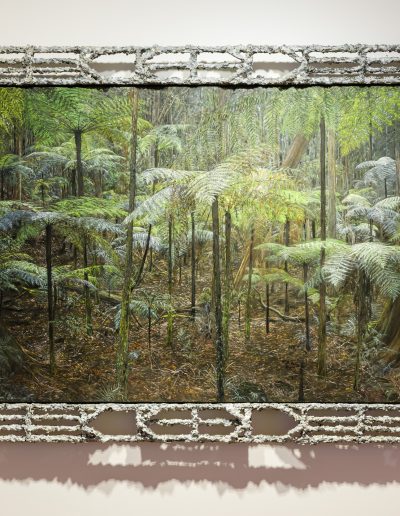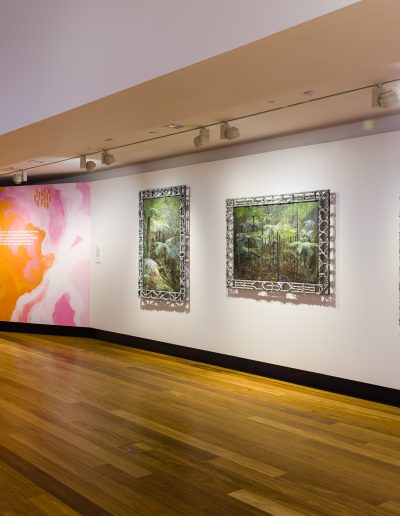The Museum of Brisbane commissioned three painting for their major 2021 exhibition City in the Sun.
Exhibition text from Museum of Brisbane:
City in the Sun uncovers and reimagines Brisbane’s subtropical image. Showcasing large-scale new contemporary artworks alongside historical imagery, the exhibition will reveal how the city’s history of migration, tourism, climate, environment and geographic location has contributed to the images of a subtropical oasis of leisure and abundance. Newly commissioned works from artists Kinly Grey, Christopher Bassi, Laura Patterson, Rachael Sarra, Sam Tupou, Sebastian Moody, Holly Anderson and Rachel Burke are coupled with works by Gerwyn Davies, Michael Zavros, Scott Redford and Olive Ashworth to name a few. The exhibition invites audiences to peek behind the sun-drenched façade of the tourist brochures and question if these images still represent who we are as a city… if they ever did.
This colourful exhibition provides playful reinterpretations, flamboyant re-imaginings and quiet reflections, proposing exciting new images of Brisbane’s subtropical identity today.
This project is supported by the Queensland Government through Arts Queensland.
The artworks pair Australian rain forest landscapes, resplendent with historically prized plant specimens, with the styles and motifs of the architecture and cases that were designed to transport and cultivate these select plants as they became separated (physically and symbolically), from their original landscapes and elevated to cult-like status.
18th century Pteridomania took horticultural and societal trends in peculiar and fanciful directions, encompassing burgeoning interest in the natural world, acceptance of female inclusive outdoor hobbies and a playful extravagance that was in stark contrast to the stillness and rigidity of the gardens and architecture preceding it.
As the popularity of collecting exotic plants grew in Europe and around the world, fascinatingly innovative developments were made in building design and engineering to permit these plants to grow in such vastly different environments. The frames of these artwork reference the designs of Victorian era glasshouses and Wardian Cases that have gradually become so aesthetically tied to the fern that one could be forgiven for forgetting just how strange it is to see subtropical rainforest plants growing happily in humid glass boxes on a landscape where temperatures drop and ice sets on the ground.
The landscapes are painted from my own photo studies of Lamington National Park, taken in 2021, documenting the pristine landscapes encountered by the English Botanist Allan Cunningham in the 1820’s, sent to Australia to expand the plant collection of the Kings Garden at Kew London. Specimens of the ‘Gully Tree Fern’ (Alsophila Cunninghamii) featured in these landscapes were ‘discovered’ and collected by Cunningham and taken back to Kew Gardens. Around this time, worldwide plant trade boomed and became a lucrative business, prompting rampant unsustainable and illegal deforestation and plant export, which is only recently coming under scrutiny.
The works examine the role Australia’s old growth rainforests have involuntarily played within the broader context of worldwide plant trade and the dire need to protect our remnant rainforests which contain some of the oldest and rarest plant specimens in the world.
These artworks are a modern interpretation of the excitement and madness of the fern craze. Rather than select specimens being taken from their ecosystem to be cultivated within manmade glasshouses, these landscapes and frames exist symbiotically. The intense beauty of these forests is not dimmed by leaving them intact and their protective framing offers glimpses of the intrigue that surrounded their history.
Exploring links between the worldwide plant trade of the 1800’s and old growth Australian rainforests. ~ Linking natural Australian landscapes and plant specimens with architectural trends and movements to which they became involuntarily and intrinsically tied. (Subtropical fern specimens in European glasshouses) (Botanist) Allan Cunningham (1791 – 1839) – sent to Australia on various expeditions in the early 1800’s. Under his title of “Kings Collector for the Royal Gardens at Kew” he was tasked with collecting and documenting plant specimens for Royal Botanic Kew Gardens (England). Australian Dictionary of Biography – Allan Cunningham (1791 – 1839) https://adb.anu.edu.au/biography/cunningham-allan-1941 Australian National Herbarium – Biographical Notes – Allan Cunningham, https://www.anbg.gov.au/biography/cunningham-allan.html Trove – Papers of Allan Cunningham, https://nla.gov.au/nla.obj-836342713/findingaid ~ Looking to find lists of plant specimens collected by Cunningham – directed to the ‘Australian Virtual Herbarium’ by botanists at the Queensland Herbarium. Queensland Herbarium https://www.qld.gov.au/environment/plants-animals/plants/herbarium Australian Virtual Herbarium https://avh.chah.org.au/
Interested in finding fern specimens linked to Cunningham… Of the many plant specimens collected and documented by Cunningham there was one type of fern (which could be also found in Queensland) that was definitively linked to Cunningham and sent back to Kew Gardens. ~ Cyathea Cunninghamii (or Alsophia Cunninghamii) ~ Note 01. Cyathea Cunninghamii seems to be a commonly used synonym of Alsophila Cunninghamii, – the collected specimen listed with the Australian Herbarium uses Cyathea Cuninghamii, so maybe slightly more correct(?) Note 02. While Cunningham definitely collected specimens of this fern – it’s listed in his journals – Rev W Colenso seems to be attributed to collecting it first. Cunningham did send a specimen to Kew Herbarium, after which J.D.Hooker (director at Kew) named the fern in Cunningham’s honour. ~ Cyathea Cunninghamii – the only Australian fern type to bear Cunningham’s name. ~ Cunningham sent a sample back to Kew Gardens, where it and other specimens like it were housed and cultivated within new purpose built glasshouses to mimick the humid environmental conditions of the subtropics. ~ The Australian Virtual Herbarium notes that a tiny remnant population of Cyathea Cunninghamii exists in Lamington National Park. – The only place they are found in Queensland.
Full Exhibition Images Here






